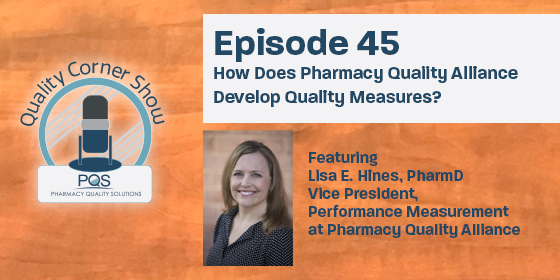Lisa Hines is PQA’s Vice President for Performance Measurement. She provides strategic direction for PQA’s performance measurement initiatives, including PQA’s approach to developing quality measures. Hines participated in a recent Quality Corner Show podcast to discuss PQA’s measure development process, which was recently updated. The podcast is hosted by Pharmacy Quality Solutions, and you can listen to the 20-minute podcast online.
Below is a Q&A adapted from the podcast. You can learn more about the updates to PQA’s measure development process in this summary document.

Tell us about your background and involvement with PQA and quality measurement?
I’m a pharmacist by training and I’ve been with PQA for five or so years and several years before that as a volunteer. I have a background in academia with research mostly focused on medication safety. I spent several years in managed care pharmacy. I started out as a pharmacist embedded in family medicine clinics, which I really enjoyed.
What are quality measures?
Quality measures help us quantify the healthcare structures, processes, outcomes, or patient perceptions that are associated with high-quality care. Good measures are tied to our broader goals for health care – and that includes whether care is safe, effective, efficient, patient-centered, equitable, and timely.
Who are quality measures made for and why do we have them?
Measures ultimately inform consumers. The purpose is to help them assess quality for themselves and then use that information to make choices that reflect their needs, values and preferences.
Providers of healthcare are another user of measures. Why? To monitor how they are doing over time from a baseline or to compare how they are doing against external benchmarks representing best practice. Providers use their quality measures scores to identify gaps in care or poor outcomes – and to make adjustments to care, if needed, and hopefully to share success.
Increasingly, quality measures also influence payment. They are used by private and public payers to incentivize high-quality care through preconditions for payment, and targets for bonuses.
How are new quality measure concepts identified?
PQA staff conduct environmental scans to identify where there are clinical and quality measurement gaps. From that, we propose measure concepts that are aligned with national quality priorities and PQA’s mission. Our members and other quality stakeholders also recommend measure concepts.
Through PQA’s Measure Concept Advisory Groups and open comment periods, our members help prioritize concepts based on:
- The supporting evidence base,
- The potential to positively impact care quality,
- The existence of similar measures,
- The availability of data sources, and
- The likelihood of adoption in the marketplace.
This process is central to our consensus-based, multi-stakeholder process and ensures we focus our resources on developing measures that are high impact.
PQA’s measure development process has been updated this year. What’s new?
We periodically refine PQA’s measure development process to increase flexibility, productivity, and relevance. We are now on version 4.0.
I’ll start with what’s not changing. We continue to use a systematic, transparent, consensus-based process to develop and maintain medication use quality measures. The end-product is an evidence-based, scientifically acceptable, feasible, and useable measure that is linked to national quality goals.
So, what’s new? Five key changes.
- Our process now aligns more closely with the CMS Measures Management System Blueprint, a “gold standard” process, which lends itself to a flexible and iterative process.
- We have enhanced patient engagement. Patient partners now serve on all our development groups and panels, so that our work is informed by individuals with related lived experience.
- We’ve moved from a single member comment period for a measure to more frequent and open comment periods to increase transparency and incorporate broader stakeholder input throughout the process.
- In addition to the comprehensive testing to assess a measure’s validity and reliability, we are now conducting earlier testing to inform feasibility and for data-driven measure specifications.
- We have shifted from broad measure development teams to focused technical expert panels that are specific to an individual measure’s clinical focus or data needs, for example.
How can pharmacists and other healthcare professionals get involved in PQA’s work and quality measurement initiatives?
Our healthcare system continues to evolve towards more patient-centered and value-based care.
As pharmacist-provided services become more broadly available and effectively utilized, we can develop and use new measures that further demonstrate their contributions toward high-quality, patient-centered care.
There are opportunities through PQA membership for individuals to get involved in measure development and to learn about quality measures and how they can be applied to their practice.
Visit the Pharmacy Quality Solutions Quality Corner Show Podcast page to hear Lisa Hines' episode discussing PQA's measure development process.

